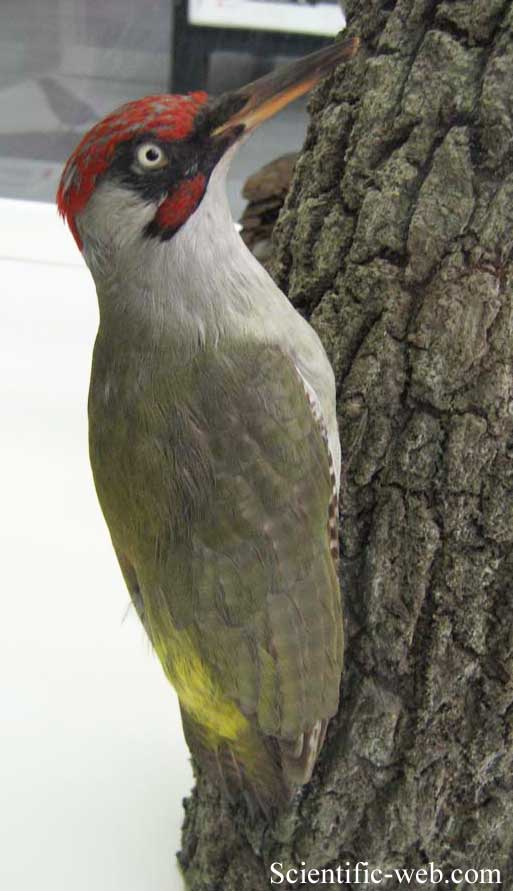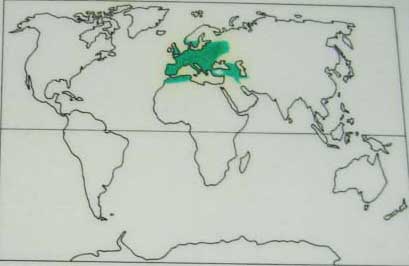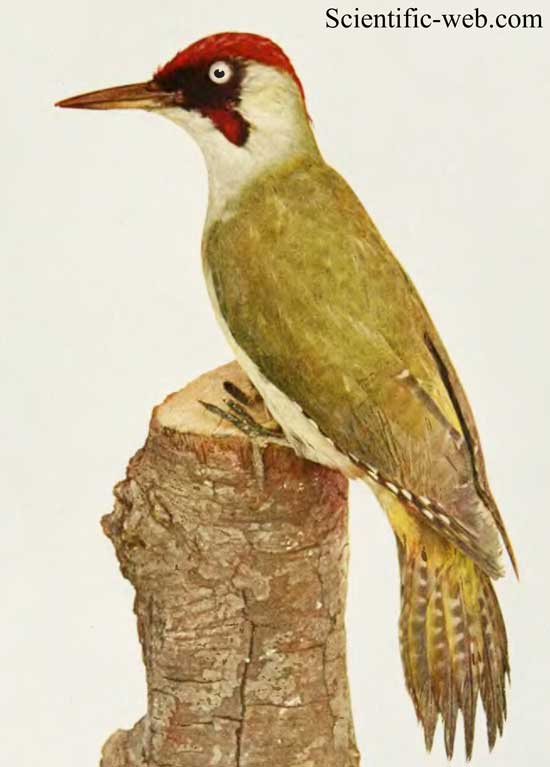Picus viridis, Photo: Michael Lahanas Cladus: Eukaryota
Picus viridis
Name Picus viridis Linnaeus, 1758 References * Systema Naturae ed.10 p.113 Vernacular names
The Green Woodpecker (Picus viridis) is a member of the woodpecker family Picidae. There are four subspecies and it occurs in most parts of Europe and in western Asia. All have green upperparts, paler yellowish underparts, a red crown and moustachial stripe which has a red centre in males but is all black in females. The Green Woodpecker spends much of its time feeding on ants on the ground and does not often 'drum' on trees like other woodpecker species. It is a shy bird but usually draws attention with its loud calls. A nest hole is excavated in a tree; four to six eggs are laid which hatch after 19–20 days. Description
Although the Green Woodpecker is shy and wary, it is usually its loud calls which first draw attention. It 'drums' rarely (a soft, fast roll), but often gives a noisy 'kyü-kyü-kyück' while flying. The song is a loud series of 10-18 'klü' sounds which gets slightly faster towards the end and falls slightly in pitch.[1] The female makes a thinner 'pü-pü-pü-pü-pü-pü-pü'.[3] The flight is undulating, with 3-4 wingbeats followed by a short glide when the wings are held by the body.[4] It can be distinguished from the similar, but smaller, Grey-headed Woodpecker by its yellowish, not grey, underparts, and the black lores and facial 'mask'.[2] In Europe, its green upperparts and yellow rump can lead to confusion with the Grey-headed Woodpecker or possibly female Golden Oriole, though the latter is smaller and more slender with narrower wings and longer tail. The closely-related,[4] very similar Levaillant's Woodpecker occurs only in north-west Africa.[1] Taxonomy The Green Woodpecker is a member of the order Piciformes, the woodpecker family Picidae and the genus Picus. It was first described by Linnaeus in 1758. The scientific name is derived from the Greek pikos, meaning 'woodpecker', and Latin viridis, 'green'.[5] There are four subspecies,[4] with subtle and mostly clinal differences between them.[2] * P. v. viridis, which breeds in Europe south to France (except south Roussillon), the Alps, northern Yugoslavia and Romania
More than 75% of the range of the Green Woodpecker is in Europe, where it is absent from some northern and eastern parts and from Ireland, Greenland and the Macaronesian Islands, but otherwise distributed widely. Over half of the European population is thought to be in France, Spain and Germany, with substantial numbers also in Portugal, the United Kingdom, Sweden, Russia, Croatia, Romania and Bulgaria.[6] It also occurs in western Asia.[4] The Green Woodpecker has a large range and an Estimated Global Extent of Occurrence of between 1 million to 10 million square kilometres, and a population in the region of 920,000 to 2.9 million birds. Populations appear to be stable, so the species is considered of Least Concern.[7] The species is highly sedentary[3] and individuals rarely move more than around 500 m between breeding seasons.[4] A combination of old deciduous trees for nesting, and nearby feeding grounds with plenty of ants, is essential. This is usually found in semi-open landscapes with small woodlands, hedges, scattered old trees, edges of forests and floodplain forests. Suitable habitats for foraging include grassland, heaths, plantations, orchards and lawns.[7] Behaviour Breeding
There is a single brood of four to six white eggs, measuring 31 x 23 mm and weighing 8.9 g each, of which 7% is shell. After the last egg is laid, they are incubated for 19–20 days by both parents taking shifts of between 1.5 to 2.5 hours.[4] The chicks are naked and altricial at hatching and fledge after 21–24 days.[5] Food and feeding The main food of the Green Woodpecker is ants of the genera Lasius and Formica[7] for which it spends much of its time foraging on the ground,[1] though insects are also taken from branches.[4] The bird's distinctive, elongated, cylindrical droppings often consist entirely of ant remains.[8] At ant nests, it probes into the ground and licks up adult ants and their larvae.[4] They have tongues that wrap to the back of their head. A study of a nest in Romania found that 10 species of ant were fed to the chicks. During the first 10 days, the young received an average of 15 g each, from days 10-20, 39.5 g, and from day 20, 49.3 g. The seven chicks consumed an estimated 1.5 million ants and pupae before leaving the nest.[4] The beak is relatively weak and used for pecking in soft wood only.[4] In common with other woodpecker species,[9] the Green Woodpecker's tongue is long (10 cm) and has to be curled around its skull.[5] It lacks the barbs of the Dendrocopos woodpeckers and Black Woodpecker[4] but is made sticky by secretions from the enlarged salivary glands.[4] Heavy, prolonged snow cover makes feeding difficult for the Green Woodpecker and can result in high mortality, from which it may take 10 years for the population to recover.[7] Ant nests can be located under the snow; one bird was observed to dig 85 cm to reach a nest.[4] In culture 'Professor Yaffle', the wooden bookend character in the 1974 children's animation series Bagpuss,[10] was based loosely upon the Green Woodpecker.[11] 'Yaffle' was among many English folk names for the Green Woodpecker relating to its laughing call; others include Laughing Betsey, Yaffingale, Yappingale and Jack Eikle. Other names, including Rain-bird, Weather Cock and Wet Bird, suggest its supposed ability to bring on rain.[12] The species has been the subject of postage stamps from several countries.[13] References 1. ^ a b c d Mullarney, Killian; Svensson, Lars; Zetterstrom, Dan; Grant, Peter (1999). Collins Bird Guide. London: HarperCollins. pp. 224–225. ISBN 0-00-219728-6. * BirdLife International (2004). Picus viridis. 2006. IUCN Red List of Threatened Species. IUCN 2006. www.iucnredlist.org. Retrieved on 11 May 2006. Database entry includes justification for why this species is of least concern
* Lees, Antony Clare (2002) The Cult of the Green Bird: the mythology of the green woodpecker. Lancaster: Scotforth Books ISBN 1904244130 Source: Wikipedia, Wikispecies: All text is available under the terms of the GNU Free Documentation License |
|




